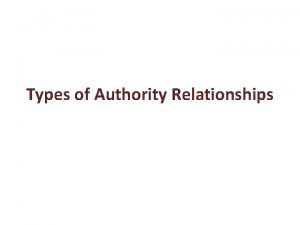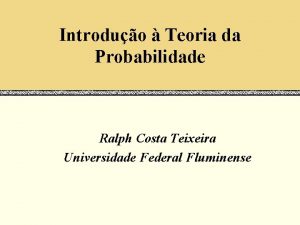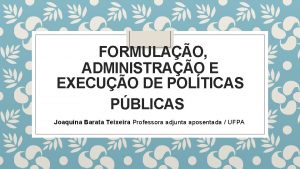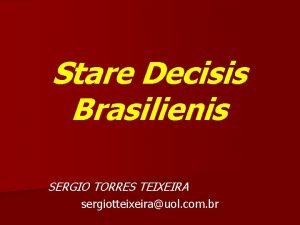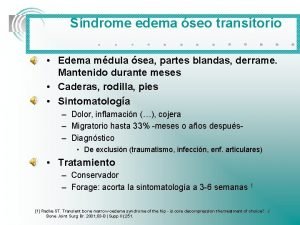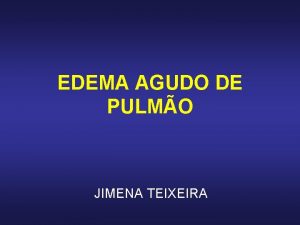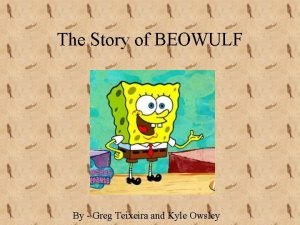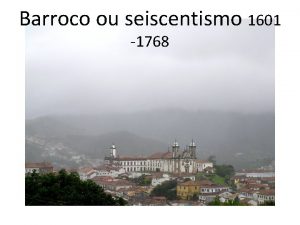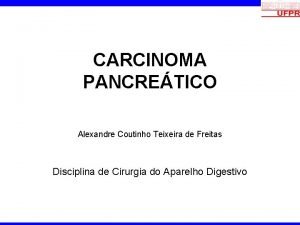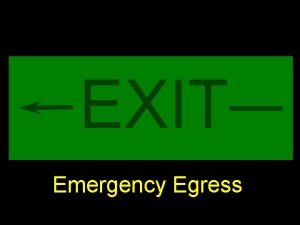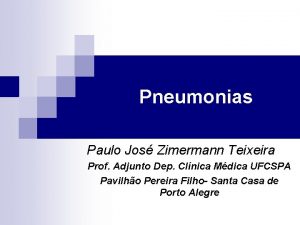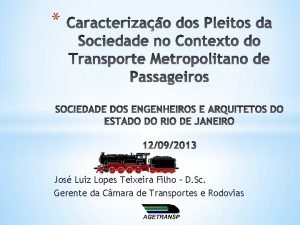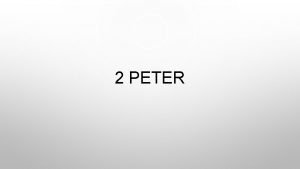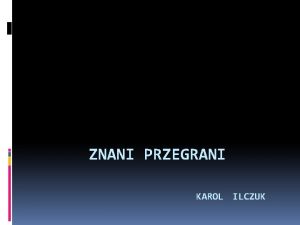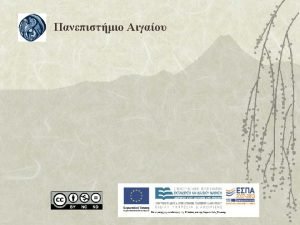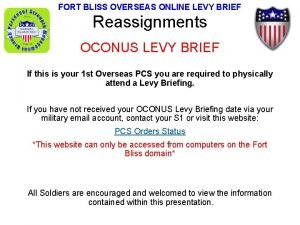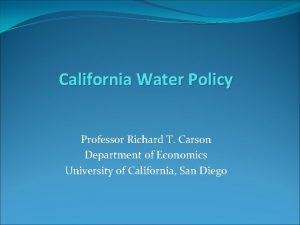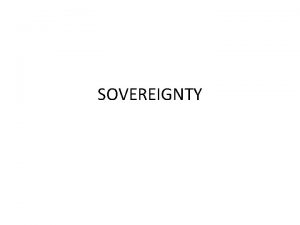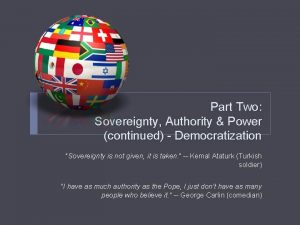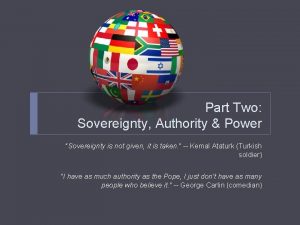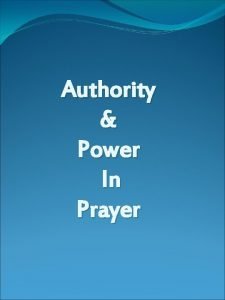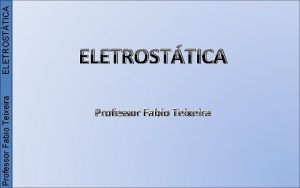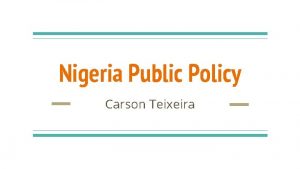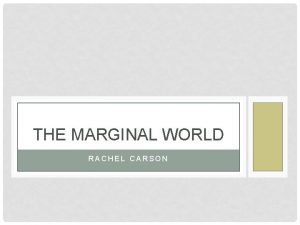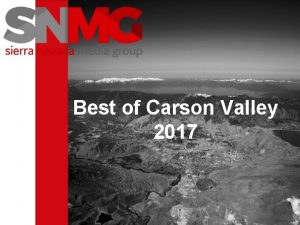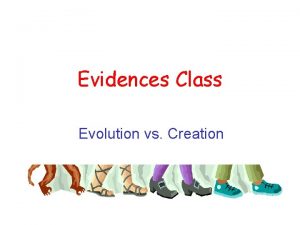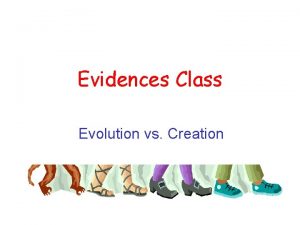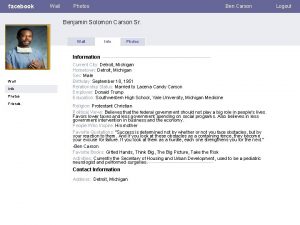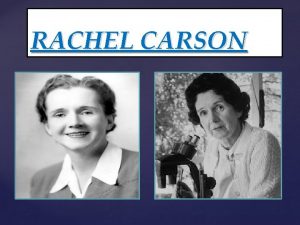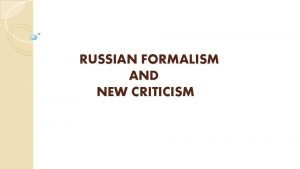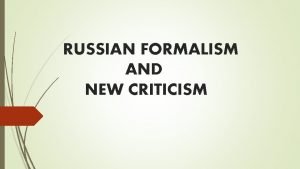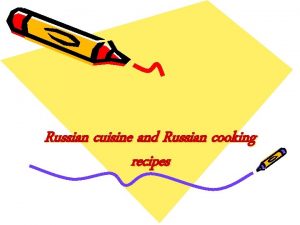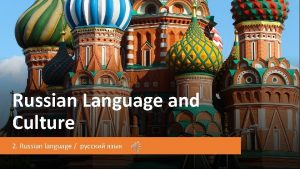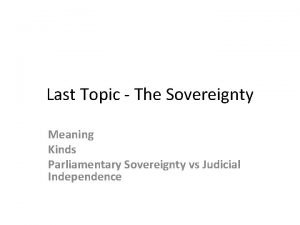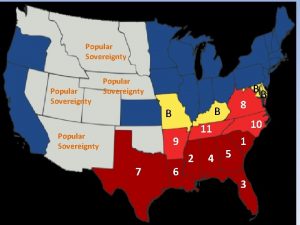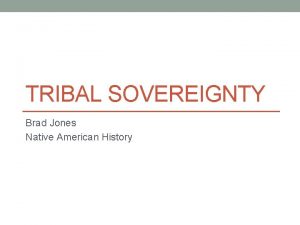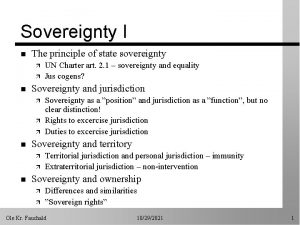Russian Sovereignty Authority and Power Carson Teixeira Quick




























- Slides: 28

Russian Sovereignty, Authority, and Power Carson Teixeira


Quick Facts Full Name: Russian Federation Population: 142. 5 million Capital: Moscow Area: 17, 075, 400 square km Major language: Russian Major religions: Christianity, Islam, Buddhism, Judaism Life expectancy: 59 years (men) 73 years (women)

The Constitution of 1993 - Establishes the Russian Federation as a democratic state. - Grants and guarantees fundamental rights and freedoms to all its people. - Establishes a semi-presidential system of government - Bicameral legislative system. (State Duma and Federation Council) - Establishes an independent Judiciary branch

Russia Today - Russia today is considered a “Post-communist Country. ” - “Post-communism” is the period of political and economic transformation or "transition" in former communist states, in which new government's aim to create free market-oriented capitalist economies. - According to the official CIA website, China, Cuba, North Korea, Laos, and Vietnam are the only five countries classified as a “communist state. ” The CIA refers to the government type of Russia as a “semi-presidential federation. ”

Semi-presidential Federation The semi-presidential system is a form of government in which a directly elected president shares executive power with a prime minister and government appointed by, and serving with the continuing confidence of, a democratically elected legislature.

Supranational Organizations - - - BRICS (Brazil, Russia, India, China & South Africa) member-states are marked by fast-growing economies, their economic potential being so significant that they are reported to become dominating economic systems by 2050. Black Sea Economic Cooperation Organization (BSEC) brings together 12 countries of the Black Sea Region and the South Balkans, namely Russia, Azerbaijan, Albania, Armenia, Bulgaria, Greece, Georgia, Moldova, Romania, Serbia, Turkey, Ukraine. Russia is NOT an OPEC member.

Distinct Russian Time Periods - 14 th century-Early 20 th century - Autocratic rule of Russia. Tsars ruled Russia until the 17 th century. Control was passed down through the Romanov family. Brutalities and assassinations often occurred during transitions. - 1917 -1991 - Communist rule began in 1917 with Vladimir Lenin’s Bolsheviks seizing control of government after the last tsar, Nicholas II. - 1991 -Present - An abrupt regime change to a democracy and free market. President Boris Yeltsin put western-style reforms in place to create Russian Federation.

Historical Legitimacy: the right and acceptance of an authority, usually a governing law or a regime. - Based on strong autocratic rule. - Czars - Under communist rule, Marxism-Leninism provided the legitimacy base for the party, with its ideology of democratic centralism. - “Stalinism” changed the regime to totalitarianism. Stalin had a much more complete form of “strong-man rule” than the Czars ever had.

Legitimacy Today - Early 21 st century legitimacy is very low, partly because the regime change is so recent. - Growing evidence that legitimacy has stabilized since Vladimir Putin was first elected president in 2000. - Putin has shown signs of retreating from the democratic process to reestablish some of the old authoritarianism from Russia’s traditional political culture.

Public Opinions President of the RF: 85. 0% 9. 4% Prime-minister of the RF: 57. 4% 28. 2% Government of the RF: 61. 2% 26. 8% State Duma 51. 6% 32. 8% Federation Council 49. 3% 21. 0%

Socialization - USSR government used heavy propaganda as tactic - Democratization and globalization has moved aways from strict government socialization.

The Revolution of 1905 - Began in St. Petersburg on January 22 when troops fired on a defenseless crowd, led by a priest, were marching to protest Czar Nicholas II. This is known as “Bloody Sunday. ” - By October, in a manifesto, the Czar granted civil liberties and a representative duma to be elected democratically. - Those satisfied with the manifesto formed the Octobrist Party. - The liberals still wanted the Duma to have more powers. This created the Constitutional Democratic Party.

Revolution of 1917 (February) - Russia’s disastrous involvement in WWI - Russian casualties were greater than those sustained by any nation in any previous war. - The economy was crippled. - Many moderates joined the Russian radicals in efforts to overthrow the Czar - After such great unpopularity, on March 15, Czar Nicholas II abdicated the throne in favor of his brother Michael, whose refusal

Revolution of 1917 (October) - Bolshevik Party leader Vladimir Lenin launched a nearly bloodless coup d’état against the provisional government lead by Alexander Kerensky. - The Bolsheviks occupied government buildings - First major “Marxist state” in the world - Fought brief civil war with anti-Bolsheviks. In 1920, the anti. Bolsheviks were defeated, and in 1922 the Union of Soviet Socialist Republics (USSR) was established.

Leaders of the USSR 1917 - Alexander Kerensky 1917 -1922 - Vladimir Lenin 1922 -1953 - Josef Stalin 1953 - 1964 - Nikita Khrushchev 1964 -1982 - Leonid Brezhnev 1982 -1984 - Yuri Andropov 1984 -1985 - Konstantin Chernenko 1985 -1991 - Mikhail Gorbachev

Fall of the USSR ~ Dec 1991 - Mikhail Gorbachev's glasnost and perestroika. - Eliminated traces of Stalinist repression, like the banning of books and the omnipresent secret police, and gave new freedoms to Soviet citizens. - Loosened the government's control on the economy - Baltic states began declaring independence from Moscow

Quiz 1. What is the Capital of Russia?

Moscow

2. What system does the executive branch function under?

Semi-presidential

3. Is Russia a communist state?

No

4. Why were the liberals of Russia not satisfied with the Czars 1905 manifesto?

They wanted more powers granted to the Duma

5. Which USSR leader lead to the end of the cold war and trend towards democratization?

Mikhail Gorbachev

Sources “ 15 Salient Features of the Constitution of Russia. ” Your. Article. Library. com: The Next Generation Library, 5 Dec. 2014, www. yourarticlelibrary. com/constitution/15 -salientfeatures-of-the-constitution-of-russia/44244/. “ 5. Sovereignty, Authority & Power - AP Comparative Government: Russia. ” Google Sites, sites. google. com/site/comparativegovernmentrussia/sovereignty-authority-power. “Constitution of the Russian Federation. ” Russian Constitution: 1993, www. politicsresources. net/docs/ruscon 93. htm. “Contact CIA. ” Central Intelligence Agency, www. cia. gov/library/publications/the-world-factbook/fields/2128. html. History. com Staff. “Russian Revolution. ” History. com, A&E Television Networks, 2009, www. history. com/topics/russian-revolution. “Infoplease. ” Infoplease, www. infoplease. com/encyclopedia/history/russian-revolution-the-revolution-1905. html. Nationsonline. org, Klaus kästle -. “___ Political Map of the Russian Federation. ” Political Map of the Russian Federation - Nations Online Project, www. nationsonline. org/oneworld/map/russia-political-map. htm. “Semi-Presidential Government in the Post-Authoritarian Context. ” Semi-Presidential Government in the Post-Authoritarian Context | Constitutional Transitions, constitutionaltransitions. org/publications/semi-presidential-government-in-the-post-authoritarian-context/. Timin, Daniil. “Is Russia Still a Communist Country? ” Russianbloggerme, Russianblogger. me, 5 Jan. 2017, russianblogger. me/is-russia-still-a-communist-country/
 Gifted hands ben carson
Gifted hands ben carson Quick find vs quick union
Quick find vs quick union The fan blade is speeding up. what are the signs of
The fan blade is speeding up. what are the signs of Line authority
Line authority Ralph costa teixeira
Ralph costa teixeira Las joaquinas avellaneda
Las joaquinas avellaneda José micard teixeira
José micard teixeira Sergio torres teixeira
Sergio torres teixeira Ximena teixeira xxx
Ximena teixeira xxx Ximena teixeira xxx
Ximena teixeira xxx Greg teixeira
Greg teixeira Steve teixeira
Steve teixeira Seiscentismo
Seiscentismo Dr luis teixeira
Dr luis teixeira Artéria mesentérica
Artéria mesentérica Antitese no barroco
Antitese no barroco Morbidez barroco
Morbidez barroco Renata teixeira strip
Renata teixeira strip José micard teixeira
José micard teixeira José micard teixeira
José micard teixeira Graduao
Graduao Carson and moo
Carson and moo Power triangle diagram
Power triangle diagram Macaulay carson culkin
Macaulay carson culkin Rachel carson was born in 1907 in springsdale pennsylvania
Rachel carson was born in 1907 in springsdale pennsylvania Fort rucker levy brief
Fort rucker levy brief Who is david carson
Who is david carson Iid carson ca
Iid carson ca Shari carson
Shari carson



